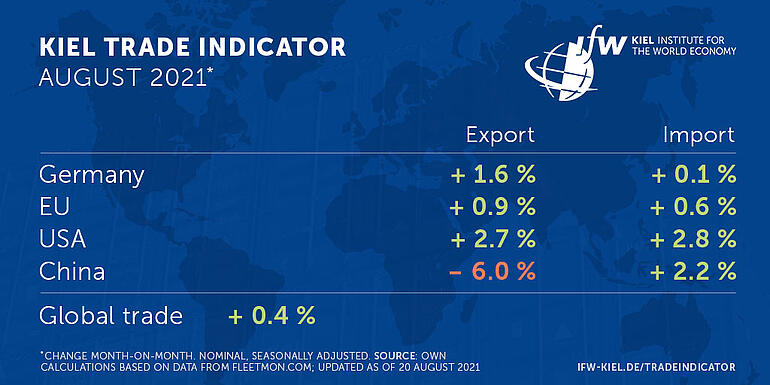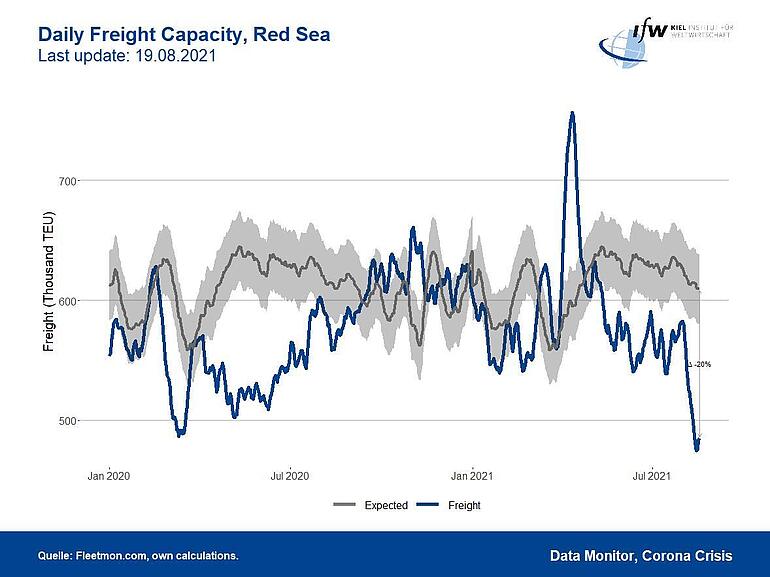News
Kiel Trade Indicator 08/2021: Trade with Asia faltering more strongly

For China's exports in particular, the Kiel Trade Indicator for August shows negative momentum with a 6 percent decline compared with the previous month (nominal, seasonally adjusted). This is due to the renewed container shipping congestion. The indicator for imports stands at +2.2 percent. Due to the high volatility in China's trade figures, this points to stagnation.
"Maritime trade is not coming to a rest. While in recent weeks there have been gentle signs of relief, the terminal closure in Ningbo is now exacerbating the bottlenecks in container traffic again. If goods trade with China does not quickly find its way back to normal processes, the crisis also threatens to make itself felt in the Christmas business with missing products and higher prices," said Vincent Stamer, Head of Kiel Trade Indicator.
In particular, significantly fewer ships left the mega ports of Ningbo and Shanghai in the past four weeks compared to the previous four weeks. However, the comparison period was particularly strong. Also due to the closure of the port of Yantian, cargo volumes in the Red Sea—the most important sea trade route between China and Europe—are currently 20 percent lower than would be expected under normal circumstances.

Total world trade in August is expected to be at the level of the previous month (+0.4 percent).
For Germany, the Kiel Trade Indicator signals an increase in exports of 1.6 percent, while imports are expected to virtually stagnate with an indicator value of +0.1 percent (nominal, seasonally adjusted).
For the EU, both imports and exports are expected to be in the black (exports +0.9 percent; imports +0.6 percent).
"This month, Germany's and Northern Europe's imports are still spared from the recent congestion in container shipping, but the rather restrained sideways movements of the indicator values give rise to fears of high uncertainty in the future," Stamer said.
For US trade, the Kiel Trade Indicator shows positive signs in both directions despite the shipping crisis (exports +2.7 percent; imports +2.8 percent).
Methodological note: The Kiel Trade Indicator measures how many goods actually leave a port. Authorities such as Chinese customs, on the other hand, record how many goods reach a port and clear customs. . Therefore, there may be significant discrepancies between the values of the Kiel Trade Indicator and official statistics.
For more information on the Kiel Trade Indicator and forecasts for 75 countries, visit www.ifw-kiel.de/tradeindicator.
The next update of the Kiel Trade Indicator will take place on September 6 (without press release) and on September 21 (with press release).
About the Kiel Trade Indicator
The Kiel Trade Indicator estimates trade flows (imports and exports) for 75 countries worldwide, the EU and world trade as a whole. It is based on the evaluation of ship movement data in real time. An algorithm programmed at the Kiel Institute uses artificial intelligence to analyze the data and translates the ship movements into nominal, seasonally adjusted growth figures compared with the previous month.
We update the data twice a month. Around the 20th (with press release) for the current and the following month and around the 3rd (without press release) for the previous and the current month.
Arriving and departing ships are recorded for 500 ports worldwide. In addition, ship movements in 100 maritime regions are analyzed and the effective utilization of container ships is derived from draught information. Country-port correlations can be used to generate forecasts, even for countries without their own deep-sea ports.
Compared to previous leading trade indicators, the Kiel Trade Indicator is available much earlier, is much more comprehensive, relies on a uniquely large database using big data, and has a low statistical error by comparison. The algorithm of the Kiel Trade Indicator uses machine learning, so that the quality of the forecast continues to improve over time.